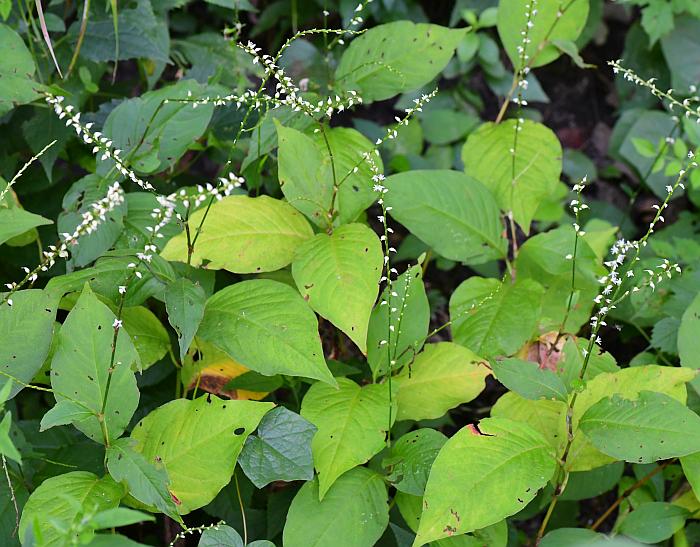Persicaria virginiana (L.) Gaertn.
Virginia Knotweed, Jumpseed

Native
CC = 1
CW = 0
MOC = 66
© DETenaglia
Persicaria virginiana (L.) Gaertn.Virginia Knotweed, Jumpseed | |
 |
Native CC = 1 CW = 0 MOC = 66 |
© DETenaglia |
|
Family - Polygonaceae Habit - Rhizomatous perennial forb, the stems not rooting at the lower nodes.
Stems - Ascending to erect, to 60 cm (below the inflorescence), glabrous or densely appressed-hairy toward the tip toward the tip, not glandular. Ocreae persistent, often tearing with age, 10-20 mm long, loosely cylindric but not noticeably inflated, light brown to brown and papery throughout, more or less truncate but often noticeably oblique at the tip, lacking a flange of tissue at the tip, the margin with bristles 0.5-4.0 mm long, the surface densely appressed-hairy, the hairs sometimes appearing somewhat woolly, not gland-dotted.
Leaves - Alternate, simple, petiolate. Petioles of the upper leaves absent or very short, progressively longer on lower leaves to 1-3 cm on lowermost leaves, appressed-hairy, mostly on the upper surface. Leaf blades 5-18 cm long, 2-10 cm wide, ovate to elliptic or obovate, those of the uppermost leaves sometimes lanceolate, angled or rounded at the base, tapered to a sharply pointed tip, the upper surface glabrous or more commonly with scatted, stiff, bristlelike hairs (similar to those of the margins), the undersurface glabrous or sparsely to moderately pubescent with softer, short, more or less appressed hairs, mostly along the veins, the undersurface often appearing finely bumpy or pebbled (especially in dried specimens) but lacking impressed glands, the upper surface sometimes with a reddish or purplish, chevron-to crescent-shaped or triangular area.
Inflorescence - Terminal and axillary spikelike racemes from the upper leaves, solitary or few per main stem, 40-130 cm long, 6-15 mm wide, erect or more commonly somewhat curved or arched, open, the nodes well-separated, the fascicles of flowers not overlapping those of the adjacent nodes, the axis easily visible between fascicles, the stalk 2-40 cm long, appressed-hairy, sometimes glabrous or nearly so toward the tip, not glandular. Ocreolae not overlapping, the margins with bristles 1-3 mm long, the surface appressed-hairy, not gland-dotted.
Flowers - Perfect, solitary or 2 or 3 per fascicle. Perianth white, greenish white, or rarely pink, bell-shaped at flowering but becoming more or less urn-shaped soon after flowering, not gland-dotted, the 4 tepals 2.5-3.5 mm long, fused toward the base, the nerves inconspicuous, irregularly few-branched, open-branched, not forming a network, not anchor-shaped. Stamens 4, somewhat exserted, the anthers yellow or pink. Filaments whitish, glabrous, 2 mm long. Anthers pale yellow to whitish. Styles 2-branched from the base, exserted, persistent in fruit to form a beak.
Fruits - Achenes 3.5-4.0 mm long, 2.0-2.8 mm wide, not or more commonly slightly exserted, bluntly 2-angled, tapered to a prominent, hooked beak, the faces convex, lacking a central hump, the surface smooth or finely wrinkled, brown to black, shiny or dull.
Flowering - June - October. Habitat - Bottomland and mesic forests, bases of bluffs, marshes, streambanks, fields, ditches. Origin - Native to the U.S. Lookalikes - None. Other info. - This species can be found throughout Missouri and is common in rich, shaded areas. Beyond Missouri it is found throughout the eastern half of the continental U.S., also ranging into Canada. When flowering it is easily identified by its relatively long, wand-like inflorescences with numerous well-spaced, small white flowers. As is the case with all members of the family, the leaf nodes are characterized by a distinctive sheath called an ocrea; in this case the ocrea is hairy and usually brown in color, but lacks bristles extending beyond the upper edge. Photographs taken at the Kansas City Zoo, 7-30-99, and in the Ozark Scenic Riverways, Shannon County, MO., 7-29-04 (DETenaglia); also at Cuivre River State Park, Lincoln County, MO, 8-25-2008; Don Robinson State Park, Jefferson County, MO, 9-16-2021; and along the Katy Trail near Dutzow, Warren County, MO, 8-18-2023 (SRTurner). |